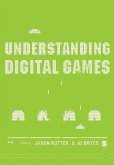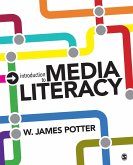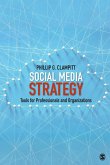- Broschiertes Buch
- Merkliste
- Auf die Merkliste
- Bewerten Bewerten
- Teilen
- Produkt teilen
- Produkterinnerung
- Produkterinnerung
Written in a straightforward and engaging style, this text takes the student through media research step-by-step.
Andere Kunden interessierten sich auch für
![Do the Media Govern? Do the Media Govern?]() Shanto IyengarDo the Media Govern?151,99 €
Shanto IyengarDo the Media Govern?151,99 €![Globalization, Development and the Mass Media Globalization, Development and the Mass Media]() Colin SparksGlobalization, Development and the Mass Media218,99 €
Colin SparksGlobalization, Development and the Mass Media218,99 €![Understanding Digital Games Understanding Digital Games]() J Rutter / J BryceUnderstanding Digital Games68,99 €
J Rutter / J BryceUnderstanding Digital Games68,99 €![Introduction to Media Literacy Introduction to Media Literacy]() W. James PotterIntroduction to Media Literacy129,99 €
W. James PotterIntroduction to Media Literacy129,99 €![Social Media Strategy Social Media Strategy]() Phillip G. ClampittSocial Media Strategy96,99 €
Phillip G. ClampittSocial Media Strategy96,99 €![Media Studies Media Studies]() Eoin Devereux (ed.)Media Studies83,99 €
Eoin Devereux (ed.)Media Studies83,99 €![Mass Media and American Politics Mass Media and American Politics]() Johanna L. DunawayMass Media and American Politics154,99 €
Johanna L. DunawayMass Media and American Politics154,99 €-
-
-
Written in a straightforward and engaging style, this text takes the student through media research step-by-step.
Hinweis: Dieser Artikel kann nur an eine deutsche Lieferadresse ausgeliefert werden.
Hinweis: Dieser Artikel kann nur an eine deutsche Lieferadresse ausgeliefert werden.
Produktdetails
- Produktdetails
- Verlag: SAGE Publications Inc
- Artikelnr. des Verlages: B60977P
- 2 Revised edition
- Seitenzahl: 272
- Erscheinungstermin: 5. März 2009
- Englisch
- Abmessung: 235mm x 191mm x 15mm
- Gewicht: 462g
- ISBN-13: 9781412960977
- ISBN-10: 1412960975
- Artikelnr.: 25328414
- Herstellerkennzeichnung
- Libri GmbH
- Europaallee 1
- 36244 Bad Hersfeld
- gpsr@libri.de
- Verlag: SAGE Publications Inc
- Artikelnr. des Verlages: B60977P
- 2 Revised edition
- Seitenzahl: 272
- Erscheinungstermin: 5. März 2009
- Englisch
- Abmessung: 235mm x 191mm x 15mm
- Gewicht: 462g
- ISBN-13: 9781412960977
- ISBN-10: 1412960975
- Artikelnr.: 25328414
- Herstellerkennzeichnung
- Libri GmbH
- Europaallee 1
- 36244 Bad Hersfeld
- gpsr@libri.de
Susanna Hornig Priest, Ph.D., has taught mass communication theory and research methods at the undergraduate and graduate level beginning in 1989. She holds a doctoral degree in communications from the University of Washington, a master's degree in sociology from the University of Nevada, Las Vegas, and a bachelor's degree in anthropology from the University of California at Berkeley. Her own research is centered on the role of science in American society and culture, its expression in the mass media, public engagement in science and science policy, and public opinion formation. She is also interested in the social roles of new media technologies. Priest has served as a member of the Research and Publications committees of the Association for Education in Journalism and Mass Communications and as chair and research chair of the Association's Science Communication Interest Group. She is a Fellow of the American Association for the Advancement of Science, past associate editor of the journal Public Understanding of Science, and current editor of the journal Science Communication. She regularly serves as an advisor to a wide range of academic projects, government agencies, and private organizations on communication, public engagement, and public opinion issues, and reviews research submissions for a variety of academic organizations and scholarly journals. Her current research is supported by grants from the National Science Foundation and other sources. Her publications include over 30 refereed research articles and nearly 20 book chapters, plus 2 books and the Encyclopedia of Science and Technology Communication, for which she served as General Editor. Currently, she is based in Camano Island, WA, and edits Science Communication.
PART I. ROOTS: SOCIAL SCIENCE FOUNDATIONS
1. A Philosophy of Social "Science"
Qualitative Versus Quantitative Methods
Deductive Versus Inductive Logic
Applied Versus Basic Research
The Limits of Social Science Research
2. Foundational Disciplines
Anthropology and the Range of Human Experience
Psychology and the Experimental Method
Sociology and the Study of Human Social Groups
3. Mass Communication as a Research Field
Origins of Mass Communication Research
Qualitative Versus Quantitative Research Revisited
Content Analysis as a Key Research Tool
Mass Communication and New Media
PART II. ASKING QUESTIONS AND COLLECTING DATA: CREATING A RESEARCH PLAN
4. Developing a Research Question, Reviewing the Literature, Exploring Data
Sources, and Defining Variables
Reviewing the Academic Literature
The Nature of Academic Publishing
Defining and Refining Your Research Questions
More About the Role of Theory
Finding Resources and Data for Your Project
Defining and Measuring Variables
5. Designing Quantitative Research: Surveys, Experiments, and Quantitative
Content Analysis
Survey Design Basics
Designing Basic Experiments
Content Analysis
6. Designing Qualitative Studies: Participant Observation, Interviews,
Focus Groups, and Qualitative Content Analysis
Participant Observation
Interviews
Focus Groups
Qualitative Content Studies
PART III. APPROACHES TO DATA ANALYSIS: BASIC TOOLS
7. Describing a Numerical Data Set and Making Inferences
Levels of Measurement
Identifying and Summarizing Patterns
Reasoning From Sample to Population
8. Testing Hypotheses and Exploring Other Relationships
Testing Simple Hypotheses
Understanding Chi-Square
Comparing Two Means
Working With Complex Variables
Multivariate Techniques for Statistical Analysis
9. Qualitative Analysis: Identifying Themes and Writing Meaningful
Summaries
Working With Theory and Identifying Themes
Analyzing Qualitative Data
Other Forms of Analysis
Writing Descriptive Summaries
Relating Data to Conclusions
PART IV. RESEARCH IN BROADER CONTEXT: CONTEMPORARY TRENDS IN THE
DISSEMINATION OF RESEARCH RESULTS
10. Research Horizons: Opportunities and Challenges
New Media Technology
Research in a Global Village
Ethics in Research: A Further Note
11. Writing and Presenting the Research Report
Constructing the Research Paper
About Conference Presentations
A Concluding Note
1. A Philosophy of Social "Science"
Qualitative Versus Quantitative Methods
Deductive Versus Inductive Logic
Applied Versus Basic Research
The Limits of Social Science Research
2. Foundational Disciplines
Anthropology and the Range of Human Experience
Psychology and the Experimental Method
Sociology and the Study of Human Social Groups
3. Mass Communication as a Research Field
Origins of Mass Communication Research
Qualitative Versus Quantitative Research Revisited
Content Analysis as a Key Research Tool
Mass Communication and New Media
PART II. ASKING QUESTIONS AND COLLECTING DATA: CREATING A RESEARCH PLAN
4. Developing a Research Question, Reviewing the Literature, Exploring Data
Sources, and Defining Variables
Reviewing the Academic Literature
The Nature of Academic Publishing
Defining and Refining Your Research Questions
More About the Role of Theory
Finding Resources and Data for Your Project
Defining and Measuring Variables
5. Designing Quantitative Research: Surveys, Experiments, and Quantitative
Content Analysis
Survey Design Basics
Designing Basic Experiments
Content Analysis
6. Designing Qualitative Studies: Participant Observation, Interviews,
Focus Groups, and Qualitative Content Analysis
Participant Observation
Interviews
Focus Groups
Qualitative Content Studies
PART III. APPROACHES TO DATA ANALYSIS: BASIC TOOLS
7. Describing a Numerical Data Set and Making Inferences
Levels of Measurement
Identifying and Summarizing Patterns
Reasoning From Sample to Population
8. Testing Hypotheses and Exploring Other Relationships
Testing Simple Hypotheses
Understanding Chi-Square
Comparing Two Means
Working With Complex Variables
Multivariate Techniques for Statistical Analysis
9. Qualitative Analysis: Identifying Themes and Writing Meaningful
Summaries
Working With Theory and Identifying Themes
Analyzing Qualitative Data
Other Forms of Analysis
Writing Descriptive Summaries
Relating Data to Conclusions
PART IV. RESEARCH IN BROADER CONTEXT: CONTEMPORARY TRENDS IN THE
DISSEMINATION OF RESEARCH RESULTS
10. Research Horizons: Opportunities and Challenges
New Media Technology
Research in a Global Village
Ethics in Research: A Further Note
11. Writing and Presenting the Research Report
Constructing the Research Paper
About Conference Presentations
A Concluding Note
PART I. ROOTS: SOCIAL SCIENCE FOUNDATIONS
1. A Philosophy of Social "Science"
Qualitative Versus Quantitative Methods
Deductive Versus Inductive Logic
Applied Versus Basic Research
The Limits of Social Science Research
2. Foundational Disciplines
Anthropology and the Range of Human Experience
Psychology and the Experimental Method
Sociology and the Study of Human Social Groups
3. Mass Communication as a Research Field
Origins of Mass Communication Research
Qualitative Versus Quantitative Research Revisited
Content Analysis as a Key Research Tool
Mass Communication and New Media
PART II. ASKING QUESTIONS AND COLLECTING DATA: CREATING A RESEARCH PLAN
4. Developing a Research Question, Reviewing the Literature, Exploring Data
Sources, and Defining Variables
Reviewing the Academic Literature
The Nature of Academic Publishing
Defining and Refining Your Research Questions
More About the Role of Theory
Finding Resources and Data for Your Project
Defining and Measuring Variables
5. Designing Quantitative Research: Surveys, Experiments, and Quantitative
Content Analysis
Survey Design Basics
Designing Basic Experiments
Content Analysis
6. Designing Qualitative Studies: Participant Observation, Interviews,
Focus Groups, and Qualitative Content Analysis
Participant Observation
Interviews
Focus Groups
Qualitative Content Studies
PART III. APPROACHES TO DATA ANALYSIS: BASIC TOOLS
7. Describing a Numerical Data Set and Making Inferences
Levels of Measurement
Identifying and Summarizing Patterns
Reasoning From Sample to Population
8. Testing Hypotheses and Exploring Other Relationships
Testing Simple Hypotheses
Understanding Chi-Square
Comparing Two Means
Working With Complex Variables
Multivariate Techniques for Statistical Analysis
9. Qualitative Analysis: Identifying Themes and Writing Meaningful
Summaries
Working With Theory and Identifying Themes
Analyzing Qualitative Data
Other Forms of Analysis
Writing Descriptive Summaries
Relating Data to Conclusions
PART IV. RESEARCH IN BROADER CONTEXT: CONTEMPORARY TRENDS IN THE
DISSEMINATION OF RESEARCH RESULTS
10. Research Horizons: Opportunities and Challenges
New Media Technology
Research in a Global Village
Ethics in Research: A Further Note
11. Writing and Presenting the Research Report
Constructing the Research Paper
About Conference Presentations
A Concluding Note
1. A Philosophy of Social "Science"
Qualitative Versus Quantitative Methods
Deductive Versus Inductive Logic
Applied Versus Basic Research
The Limits of Social Science Research
2. Foundational Disciplines
Anthropology and the Range of Human Experience
Psychology and the Experimental Method
Sociology and the Study of Human Social Groups
3. Mass Communication as a Research Field
Origins of Mass Communication Research
Qualitative Versus Quantitative Research Revisited
Content Analysis as a Key Research Tool
Mass Communication and New Media
PART II. ASKING QUESTIONS AND COLLECTING DATA: CREATING A RESEARCH PLAN
4. Developing a Research Question, Reviewing the Literature, Exploring Data
Sources, and Defining Variables
Reviewing the Academic Literature
The Nature of Academic Publishing
Defining and Refining Your Research Questions
More About the Role of Theory
Finding Resources and Data for Your Project
Defining and Measuring Variables
5. Designing Quantitative Research: Surveys, Experiments, and Quantitative
Content Analysis
Survey Design Basics
Designing Basic Experiments
Content Analysis
6. Designing Qualitative Studies: Participant Observation, Interviews,
Focus Groups, and Qualitative Content Analysis
Participant Observation
Interviews
Focus Groups
Qualitative Content Studies
PART III. APPROACHES TO DATA ANALYSIS: BASIC TOOLS
7. Describing a Numerical Data Set and Making Inferences
Levels of Measurement
Identifying and Summarizing Patterns
Reasoning From Sample to Population
8. Testing Hypotheses and Exploring Other Relationships
Testing Simple Hypotheses
Understanding Chi-Square
Comparing Two Means
Working With Complex Variables
Multivariate Techniques for Statistical Analysis
9. Qualitative Analysis: Identifying Themes and Writing Meaningful
Summaries
Working With Theory and Identifying Themes
Analyzing Qualitative Data
Other Forms of Analysis
Writing Descriptive Summaries
Relating Data to Conclusions
PART IV. RESEARCH IN BROADER CONTEXT: CONTEMPORARY TRENDS IN THE
DISSEMINATION OF RESEARCH RESULTS
10. Research Horizons: Opportunities and Challenges
New Media Technology
Research in a Global Village
Ethics in Research: A Further Note
11. Writing and Presenting the Research Report
Constructing the Research Paper
About Conference Presentations
A Concluding Note








